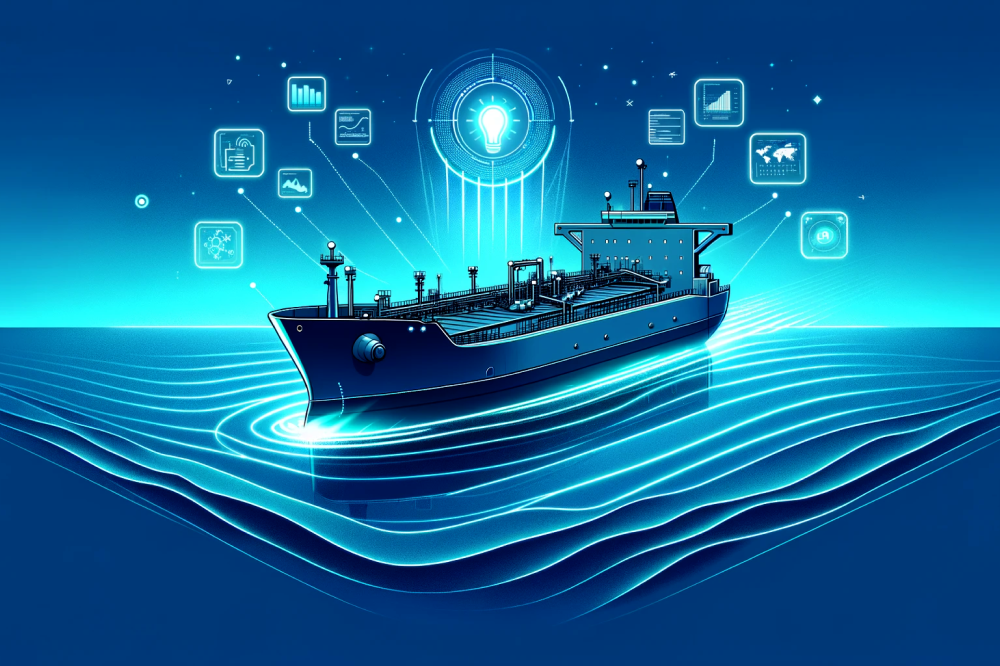
The maritime future has arrived - Get ready to embark on a maritime digital journey
Traditionally change management strategies and business transformations usually end once the new and wanted behavior has been achieved and digital transformation has become a word meaning different things to different people. However, it seems like digital transformation often is defined as how to get an organization to continuously improve and change and make that ability an advantage. The timeline includes today and tomorrow, and it must be a part of the company's DNA because the digital transformation process will last forever. Therefore, most of today's executives will be on this journey for the rest of their careers. So you better get ready!
Maritime digital transformation is a continuously rebuild of the maritime companies business model and how your organization is fitted to drive continuous innovation in a quickly and constantly changing world.

Maritime digital transformation is critical for any organizations within the maritime cluster, not only to be able to compete but to survive. McKinsey says: Successful companies don't just use digital tools; they become digital, and new technologies such as AI makes this process an everlasting dynamic process.
Maritime software solutions today
The shipping industry is an industry of many small and medium-sized companies. Most small and medium-sized businesses are using old legacy maritime software solutions that don't fit their needs and are rigid and expensive to change. The legacy software is likely not a SaaS or cloud solution, so integrations with other legacy softwares are expensive. The companies often operate on many different softwares shown on many monitors.
Maritime employees waste a lot of time toggling on and off the right software and searching for relevant information. Legacy software often comes with poor or expensive support and a very old-fashioned design and poor user interface. A study done by Harvard says that decision-makers in general often have 6-8 screens shown simultaneously. So how can companies expect to compete in the digital age with outdated software that no one wants to use?
So the first step for many maritime companies is to update their existing software solutions, but very quickly, they find it too expensive to justify the investment and to maintain it.

Be curious and demystify maritime tech and the maritime tech buzzwords
Demystify the tech. If you need help to understand what AI, ML, Cloud software, IoT, AR, and VR are about and how they can influence the maritime industry, find someone who can explain so you understand what these technologies mean for the maritime industry. Put together teams, ask questions, and learn what all these technologies mean for the maritime industry and your organization.
When you have learned the meaning behind the buzzwords;
- try to understand and leverage the maritime tech,
- the world of connectivity and accessibility,
- Maritime data and data security/cyber space,
- Evaluate the capabilities of these maritime technologies to create a better ROI for your company, today and in a long term perspective.

Then start preparing your strategy and your roadmap, and remember to start preparing your colleagues to join in on building a new agile and winning culture. Remember this process will take time, and in fact, it will never end, so make sure you define short- and long-term strategic goals and celebrate the milestones as a team when you reach your milestones. Digital transformation can only be achieved if a team in in it to win it together.
The strategy needs to include what skills and people your organization need, how to organize your work, and how to recruit and keep new talents. Make sure you organize people in teams with different experiences and backgrounds so you avoid the silos the old legacy software has created.
Remember, if the legacy maritime software is rigid, it has influenced how you are organized and if your colleagues have been put into silos, they might be hard to move into a cross-disciplinary team mindset. It is hard for your colleagues to be innovative and agile and respond to new business opportunities if they have been working in silos and they’re not equipped with the proper software tools.

Pick the right maritime software today for the future
So you can start making better decisions today with tomorrow’s maritime solutions. One essential requirement for choosing the right software is that your customer must have a different and better experience dealing with you. Will you be able to continue sending invoice for the same services you charge for today, or will your services be delivered in another way? Most of the businesses in the shipping industry have a transaction or project-based business models, and many companies operates on a "no-cure-no-pay" model, where they don't get paid unless they create a transaction. When deciding on a new software, you should ask yourself “What system will benefit my customer and strengthen our commercial relationship”?
Another requirement for picking a new maritime software is that your colleagues using the new software must find benefits by using it. They must feel they are saving time, reducing manual and repetitive work, and better understanding the business opportunities and challenges so they can make better decisions. Employees will also want software where they can learn to improve if they make errors or, even better, be notified before they make wrong decisions.
In recent years, numerous software products have been developed that aim to assist maritime companies in their decision making processes. Many of these software products are based on the availability of Automated Identification System (AIS) data.
Access to reliable maritime data is crucial to successful maritime digital transformations. Data architectures should produce data that are easily accessible by teams across your organization and should continually be processed and updated. That’s also why ShipIntel has partnered with:

Avoid choosing rigid software that organizes your colleagues in silos. That will be very expensive for your organization, waste talents and make it hard working in cross-disciplinary teams, which is a necessity. Look for maritime software that empowers maritime professionals to unlock their digital potential by providing smart and easy-to-use software based on industry knowledge, big data, and algorithms.
Last and as always, the management must embrace all cultural and technological changes and processes. The management must lead the way. So you better get ready as soon as possible.
A plan for unlocking your maritime digital potential!
- Map your customers and the different type of needs among your colleagues. Understand your customers' business models and pains.
- Study your company’s business model. As mentioned above: “Will the customer accept you invoicing for the services you provide today? Will you deliver the services to your customers like you do today? Or will it change? If it changes, will you have a software system helping you to find and see that a change is taking place?
- Study your existing software and its weaknesses. Map new available maritime software and find their offerings. Remember you can ask vendors to talk together if you don’t find one maritime software solution having it all.
- Don't build your private platform. That will be very expensive to update and maintain. Focus on the platform's functionality and diversity and what modules the vendors may have ready for implementation. Search for and find a platform that offers 70-80 % of your needs and do programming around deficiencies. Make sure the platform is cloud-based, and the software is modular. Speed and adaptability can only occur for businesses that have software systems well integrated and easy to use. According to Harvard University, flexibility comes from software platforms that allow many applications to work with the same data and support functions like integration capabilities, workflow, analytics, journey mapping, and content management.
- Make your maritime software and technology roadmap (choose the right software and plan the MVP implementation) based on your needs. Talk with available software vendors, go see the talents in the universities, and define a budget. Your future success depends a lot on the tech and software you choose today, and the colleagues you have in your organization today. As with every change, it is always about the people and how you work together.

So whether you are a ship broker, ship owner, or cargo owner, working in ship finance, banking, or marine insurance, or with a classification company, technical manager, supplier, or shipping agent, get started with your strategy and roadmap for you maritime digital transformation today.
References:
McKinsey: What is digital tranformation?
Harvard Business review: Do you have the right software for your digital transformation?
Accenture: Digital transformation index















